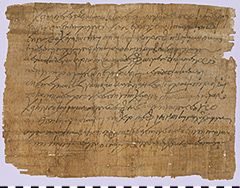BGU III 874 (P. 2748)
Through letters we learn a lot about the people of former times and gain insights into their everyday lives. However, many letters are difficult to understand, especially because of their lack of context, and the correspondence is not always comprehensible, which is also the case with the find here.
The papyrus probably originates from Fayum, a large oasis southwest of Cairo. This area was called Arsinoites in antiquity and had already been used intensively for agriculture since the Middle Kingdom. The papyrus was acquired for the Berlin Papyrus Collection in a large purchase in the years 1877–1881, but the exact place of discovery is unknown.
On the front of the papyrus, the so-called recto, twelve lines of Greek text can be seen. It is interesting that the text was not written parallel to the fibres of the papyrus – as is usually the case – but across them. This is because the papyrus was turned 90° before the inscription, so that the fibres of the recto now run vertically. In technical language, this is called transversa charta. The rotation of the papyrus is made even clearer by a leaf glue that can be seen across the writing support at the level of the last line of the text. The leaf folds and respective tears suggest that the papyrus was rolled from below and flattened at the end. Due to the Byzantine script, which is characterised by lowercase letters and long ascenders and descenders in the individual lines, the text can be dated to the 6th century AD.
The letter evidently follows a previous epistolary order, to which reference is made in the first sentence. The addressee, who is unknown to us, is to send to Narmouthis in the southwest of the Arsinoites to receive two gold pieces. The likewise unknown sender of the letter is to be informed about the execution of this order. In addition, the recipient is to go to a certain Phoibammon to acquire grain. In addition, the scribe reports that he has inquired of one Elias about expenses, although it remains unclear what these were for. At the end of the letter, greetings are extended to the family and relatives.
Despite the limited and incomplete information contained in this letter, some conclusions can be drawn. The greetings to the family make this document appear to be a letter. However, the salutation at the beginning of the text and the address on the back are missing. In conjunction with the rather personal tone of the letter, they further suggest a close relationship between sender and addressee. Perhaps the two were even related. The assurance of faith that forms the conclusion of the letter at least suggests this. In general, the letter can be assigned to a Christian context, which is visible in the Christogram with which the letter begins. In terms of content, however, the orders are mainly about a business relationship.



